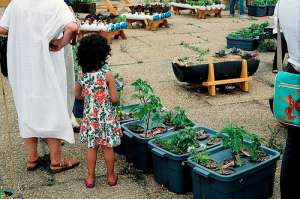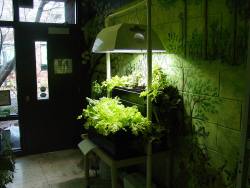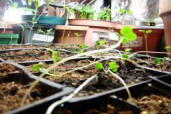The Urban Farmer, Issue #029 * Indoor Garden? * Climate Requirements * Spindly
Seedlings
October,
2010:

“Why
try to explain miracles to your kids when you can just have them plant a
garden?”
~Robert Brault
AN INDOOR GARDEN FOR YOUR HOUSE?

Indoor Hydroponic Gardening Tips
If you are someone who loves gardening, but lives in a climate with a short
growing season, then an indoor hydroponic garden is the perfect alternative to a
blossoming garden outdoors.
Hydroponic gardening is a year-round, productive and pesticide-free way to grow
fruits, herbs, vegetables and flowers, in a flow of nutrient-based water,
instead of soil. A hydroponic garden can be placed either indoors or outdoors,
to suit your requirements.
Things Required
Normally, indoor hydroponic gardening comprises of the following things as its
chief components – a growing tray, a reservoir, and a pump to supply nutrients
to the plants. Since hydroponic gardening doesn’t require soil as the anchoring
medium, an inert soil-free medium like fiber, sand or stone is substituted, to
support the roots of the plant in the hydroponic system. Care should be taken
that the hydroponic medium is porous, so as to allow proper retention of air and
water.
Micro-nutrients & PH Balance
While maintaining a hydroponic garden indoors, ensure that you provide the
required fertilizers and high quality micro-nutrients, to foster productivity of
your plants. Nutrients like sulfur, magnesium, cobalt, calcium, iron, boron,
zinc, manganese and copper can be used to engender maximum yield. Another
important thing that requires consideration is the PH balance of the nutrient
solution. Make sure that there are no fluctuations in the PH balance, as it can
affect the nutrition-absorbing capacity of the plant and thus disturb its
overall health. The above mentioned components are also applicable in case of
outdoor hydroponic gardening, but with some variations.
Benefits of Indoor Hydroponic Gardening
Maximum Yield
The plants in an indoor hydroponic garden grow faster, as compared to those in
the outdoor gardens, because they are given very easy access to nutrients, food
and water.
Limited Space Requirement
Indoor hydroponic gardening enables you to best utilize the limited space in the
premises of your home. This helps you to keep a vigil on the growth and
nourishment of each and every plant growing there, in case you are gardening on
a large scale.
Low Level Of Maintenance
In an indoor hydroponic garden, the plants require very low maintenance, as they
are grown in a limited space, where they get all the nutrients quite
sufficiently.
Better Taste & High Nutritional Value
According to the latest study, the fruits and vegetables growing in indoor
hydroponic gardens are tastier than those grown in soil. Moreover, such food
items are healthier as well, because they contain more vitamins and other
nutrients.
Other Benefits
The other benefits of indoor hydroponic gardening are that it is
environment-friendly and can be maintained pesticide-free if desired. At the
same time, it involves low water requirement and low carbon emissions. Last, but
not the least, it helps maintain high level of sustainability and balanced plant
growth.
BACK TO THE BASICS: CLIMATE
REQUIREMENTS
Your plants need a temperature range of 65-80 degrees. Can you provide that? Do
you have enough heating or air conditioning to create the proper atmosphere? One
of the major mistakes beginners make is in overlooking this one very important
requirement.
You cannot grow tomatoes in a 40 degree
basement or lettuce on a 90 degree patio. It just doesn’t work! *Note: Your
plants can tolerate occasional dips as low as 45 and as high as 90, but the
routine growing range needed is 65-80.
The nutrient solution must be kept cool… between 60-75 degrees. This means you
can’t keep the vat out on a hot patio without providing insulation or some other
means of keeping it cool. There are other ways to do this (water chillers) but
they are expensive.
Your hydroponics setup can’t be directly out in the rain, as it will dilute and
overflow your system and get the electrical equipment wet. Bad combination.

Hydro Tip of the Month
Are your seedlings all tall and spindly, even flopping over?

The problem: Not enough light. You would think it would be the opposite, but
it’s not. When the light is too dim or too far from the seedlings, they strain
towards the light, making them almost unusable for transplanting. Give your
seedlings strong and close lighting if you want stocky, sturdy baby plants.
We hope you have enjoyed this issue of The Urban Farmer Ezine. Each month, we will bring you another inspiring photo, gardening quote or idea, plus fresh new hydroponics news, techniques & products.
Insiders tips to get you growing…

~Stella and Simon from
Hydroponics-Simplified.
|


Reply